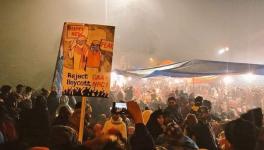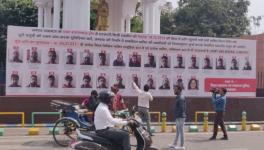Anti-CAA Protests: Row Over Hoardings in Lucknow Naming Those Accused of ‘Damaging Public Property’

New Delhi/Lucknow: The Uttar Pradesh government has put up numerous hoardings of alleged anti-CAA protesters at prominent intersections across the entire state capital of Lucknow.
In separate hoardings across the city, 57 persons have been identified. These hoardings have come up under four police station areas -- Hazratganj, Thakurganj, Hasanganj and Qaiserbagh.

The hoardings have the photographs, names and even addresses of those accused of violence during protests against the new citizenship law in Lucknow on December 19 last year. These alleged protesters have been asked to pay compensation for damage to public property that took place during the anti-CAA protest. The message written on the hoardings even says that the property of these people would be attached if they fail to pay the compensation. The total damage listed in the hoardings amounts to Rs 1.55 crore.
Newsclick has learned from its highly placed sources that the order to put up the hoardings was given by none other than state chief minister Yogi Adityanath.
Robin Verma, one of the alleged protesters, whose picture has appeared on one hoarding, said: " The matter is still in the court. This is strange. What if my house is attacked by anti-social elements? If anything like that happens then Lucknow police and administration will be fully responsible for it."
Social activist Deepak Kabeer, in a video statement released by him, said: "We were arrested, assaulted, sent to jail and then given bail. I got a recovery notice in jail and later they sent me a recovery order.”
"You (the government) know our addresses, we have the notice. Then why this? Is this to create fear? This is nothing but a new tactic to create pressure on us," he added.
Sadaf Jafar, the lone woman who appears on the hoardings, said the government should have done so only if any of the people had fled or given police a slip.
"This has made us more vulnerable now. Making our addresses public may invite a mob and this is not at all justified. I feel scared now. This step was not at all required since the matter is in court, and we all have been appearing in the courts when asked to," she added.
Former IPS SR Darapuri, one among those featuring on the hoardings, said his name came up on a day when he had got a stay on his property attachment notice. He is seeking legal help once again.
"By putting hoardings across the city, the government is inviting a mob to lynch us. When it is not proved that we are 'rioters' how can this government name and shame us," asked Darapuri.
Darapuri also said that he would challenge this in High Court once it reopens after Holi (March 10).
"As of now, I am sending a mail to the Lucknow police commissioner, UP DGP, District Magistrate, Lucknow and Principal Secretary, Home, that making hoardings with our addresses is unconstitutional and our life is at risk. If anything happens to us, then the government and district administration will be solely responsible,” he added.
The notice of property recovery is already being challenged in Allahabad High Court.
"If they (the state government) are gearing up to confiscate anyone's property, then they have to send them a notice, but they did not do so. When this case is already challenged in SC and the High Court has put stay on it, how can the government do this to us?" the former IPS officer said.
It may be mentioned that the Allahabad High Court in February last provided interim relief to a resident of Kanpur city, who was accused of destroying public property. The court stayed a similar property attachment notice served to him by the government of Uttar Pradesh, saying that the Supreme Court was already looking into the validity of such a notice in a different case.
What Legal Experts Say
Many legal experts that NewsClick spoke to, termed the Adityanath government’s move for property confiscation as “blatantly illegal”.
Senior Supreme Court advocate Sanjay Hegde said: “Confiscation of property is normally after a criminal trial”. He said the action was “legally suspect” and would be subject to further legal challenges. “Normally provisions for forfeiture of property are only after the end of a criminal trial. So there cannot be any ipso facto confiscation”, he added.
When asked about alleged human rights violation, if any, another lawyer, Abu Bakar Sabbaq, told NewsClick, "It is violation of the ‘right to live’ and 'right to liberty' under Article 21 of the Constitution which the Supreme Court. Even due process of constitutional and criminal law says that until a guilt is proved, the (accused) are innocent."
"There is a ruling of the Supreme Court for property damage that the High Court will assess the conviction of the accused. When the judicial magistrate prepares the file of violence and involvement of people, then the High Court can approve it. It is totally illegal to give notice before any action is taken," he said.
Another senior advocate also termed the action “blatantly illegal”. “This is grossly unconstitutional and illegal because it is not supported by any law and results in pre-judging people without the benefit of a fair trial."
“It is particularly pernicious in this case because there is a serious allegation that a lot of the violence was instigated by third parties and by the police themselves. In fact, it was also alleged that it was perpetrated by the police themselves,” he added.
Uttar Pradesh had witnessed large-scale violence between December 19 and 20 after protests against the Citizenship Amendment Act and Nationl Register of Citizens turned violent in many places. As the protests turned violent at a few places, at least 23 people were killed—most of them had bullet injuries—in Meerut, Kanpur, Bijnor, Firozabad and other places. Most of the dead were daily wagers.
As part of the crackdown, the UP Police arrested thousands of people across violence-hit districts and slapped serious charges on them, such as rioting and attempt to murder.
Meanwhile, many lawyers and a fact-finding team have raised questions over police excess and action, including how the police in many areas seemed to have indulged in excesses in dealing with the situation.
It may be noted that in January, a court in Western Uttar Pradesh's Bijnor granted bail to 48 people accused by the state police of rioting and attempted murder during the December violence. Rebuking the UP police for its shoddy investigation, the district sessions court judge, Sanjeev Pandey, made some scathing observations against police investigations in the case. In his bail order, the judge said: "The police FIR says the mob fired at the cops, but no evidence has been presented in court to show any recovery of weapons. The government lawyers have failed to produce any evidence before court that shows that anyone part of the mob fired at the police."
Similarly, after UP police failed to produce evidence, a sessions court in Rampur on February 7 granted bail to 15 more people arrested for allegedly indulging in rioting during anti-CAA protest in the district. The court of district and sessions judge, Alka Srivastava, accepted the bail plea and directed them to furnish two bail bonds of Rs 50,000 each, following which they could be released.
Get the latest reports & analysis with people's perspective on Protests, movements & deep analytical videos, discussions of the current affairs in your Telegram app. Subscribe to NewsClick's Telegram channel & get Real-Time updates on stories, as they get published on our website.
























